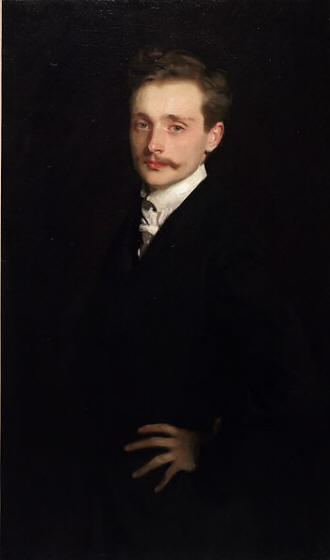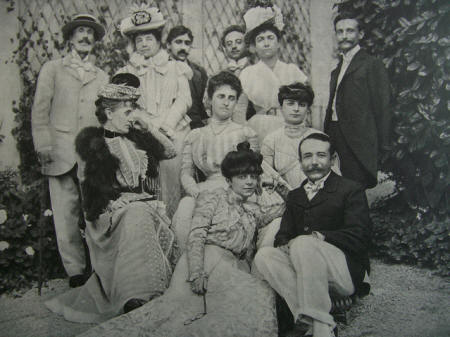

Queer Places:
Rue d'Antin, 75002 Paris, France
 Léon
Delafosse (January 4, 1874 - 1955) was a French composer and pianist.
His musical works included études, arabesques, waltzes and nocturnes.[1] It
has been claimed that he was the model for the character of Charles Morel, a
violinist portrayed in Marcel
Proust's novel In
Search of Lost Time.[2]
Delafosse was also painted as the subject of a portrait by
John
Singer Sargent.[3] The
portrait currently
resides in the Seattle
Art Museum.[4] Sargent
had also dedicated "The Grand Canal Venice" to Delafosse, writing in the
inscription "à Léon Delafosse en toute admiration et amitié".[2]
Given his own skill at the piano, John Singer Sargent was especially inclined
to extend his generosity to keyboard virtuosos (such as
Percy Grainger, Léon
Delafosse, and Gabriel Fauré), with whom he often played four-handed duets.
Léon
Delafosse (January 4, 1874 - 1955) was a French composer and pianist.
His musical works included études, arabesques, waltzes and nocturnes.[1] It
has been claimed that he was the model for the character of Charles Morel, a
violinist portrayed in Marcel
Proust's novel In
Search of Lost Time.[2]
Delafosse was also painted as the subject of a portrait by
John
Singer Sargent.[3] The
portrait currently
resides in the Seattle
Art Museum.[4] Sargent
had also dedicated "The Grand Canal Venice" to Delafosse, writing in the
inscription "à Léon Delafosse en toute admiration et amitié".[2]
Given his own skill at the piano, John Singer Sargent was especially inclined
to extend his generosity to keyboard virtuosos (such as
Percy Grainger, Léon
Delafosse, and Gabriel Fauré), with whom he often played four-handed duets.
Delafosse was born poor. His mother was a concierge, who also taught him piano as a child.[5] Delafosse became a student of Antoine François Marmontel (1850-1907) at the Conservatoire de Paris. He gave his first recital at the age of seven, and won first prize at the Conservatoire at age 13.[6] He subsequently became the protégé of the poet Robert de Montesquiou (1855-1921),[7] the countess Metternich and the princess Rachel de Brancovan. He gave recitals, but also wrote compositions for piano, including Soirée d'amour (1895), Quintette des fleurs (1896), Mandolines à la Passante and Cinq Fantaisies, and a Concerto (1898) and a Konzertstück for piano and orchestra. In 1894 in the drawing room of the Comtesse de Sassine he met Marcel Proust;[8] they became friends, and he set one of Proust's poems, "Mensonges" (Lies) to music.[2][5] Delafosse dedicated compositions to both Montesquiou and Proust. Montesquiou called him "The lion of the piano".[6] Both writers would later distance themselves from Delafosse, making him no longer welcome in Parisian literary salons. When a friend suggested to Proust to organize a concert with Delafosse, Proust replied that he would rather not see him: "M. Delafosse, qu'il me serait peu agréable d'avoir chez moi" (Delafosse, whom I would not like to have at home).[9]
Percy Grainger was a friend of Leon Delafosse, who had premiered Gabriel Fauré's Theme et variations (a set that Grainger would later declare to be 'high favorites of mine") in London in 1896. He dedicated his early Paraphrase on Tchaikovsky's Flower Waltz to Delafosse, who performed it several times in London and reciprocally dedicated several piano preludes to Grainger.

From left to right, standing: Prince Edmond de Polignac, Princess of Brancovan (Rakoul (Rachel) Musurus), Marcel Proust, Prince Constantin Brancoveanu (brother of Anna de Noailles), and Léon Delafosse. 2nd row: Madame de Montgenard, Princesse de Polignac, Countess Anna de Noailles, 1st row: Princess Helen Caraman-Chimay (sister of Anna de Noailles), Abel Hermant
Delafosse's break with Montesquiou, who'd promoted him aggressively in the beau monde, was predictably violent when it came. In Les Pas effacés, his vindictive, posthumously published memoirs, Montesquiou boasts of having dismissed his protégé thus: "Try to ensure that my love for your art is greater than my loathing for yourself." Montesquiou gleefully reports that Delafosse's next patron was an elderly Swiss woman with enormous feet who permitted the young man to play only for duchesses and queens at Monte Carlo. Poor Leon Delafosse, three years Marcel's junior, lived on and on with nothing more to boast of than that Marcel Proust had decanted the lowest villain of the Search from him. He died a pauper in 1951 but survives grotesquely, giantly, as Charlie Morel.
Delafosse was known for his interpretations of Chopin[3] and Lizst.[6] He often performed in the drawing room of Countess Saussine, and gave several private recitals at the Salle Érard in 1893/1894. In 1896 Delafosse gave a series of concerts in London with the famous Belgian violinist Eugène Ysaÿe to a mixed reception.[6][10]
My published books: